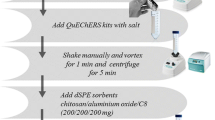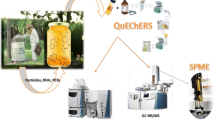Abstract
Imidacloprid is a new insecticide with a wide range of action. Because honeybees are very sensitive to this substance, two techniques (HPLC–UV and GC–MS) which enable its detection in several matrices of both animal and vegetable origin were used to monitor its possible presence in cultivated land. In the first method quantification of imidacloprid in honeybees was achieved by use of the external standard method; the detection limit was 50 mg kg−1, the linear range 0.05–1 mg mL−1, recovery 60–83%, and the imprecision (coefficient of variation) 8.6% for repeatability and 11.8% for reproducibility. Recovery from pollen was 71–98% in the range 0.05–0.5 mg kg−1. The repeatability was 9.2–13.9%. Imidacloprid can often be found in the environment, not as a simple molecule but as a group of degradation products. The GC–MS method could be used to quantify all these species as oxidation products and to determine the initial quantity of imidacloprid by use of a conversion factor. The liquid chromatographic analysis could be used to detect, in a standard solution, 10 ng mL−1 derivatized 6-chloronicotinic acid. The linearity was good (R=0.999) over a wide concentration range (10 μg mL−1–10 ng mL−1). Several samples with different matrices (filter paper placed on an pneumatic corn seed drill, grass, flowers, honeybees, etc.) obtained during the sowing period for imidacloprid-treated corn were analyzed. The quantification limit (LOQ) was 0.005 mg kg−1 for grass and flowers, 0.002 mg kg−1 for honeybees, and 0.024 mg kg−1 for paper filters.
Similar content being viewed by others

References
Sheets LP (2001) In: Krieger R (ed) Imidacloprid: handbook of pesticide toxicology. Academic Press, San Diego, pp 1123–1130
Kidd H, James DR (1991) The agrochemicals handbook, 3rd edn. Royal Society of Chemistry, Cambridge, UK
Meister RT (1994) Farm chemicals handbook. Meister, Willoughby, OH
Roberts T, Hutson D (1999) Metabolic pathways of agrochemicals. Part 2: insecticides and fungicides, Royal Society of Chemistry, Cambridge, UK
Baid D, Lummis SCR, Leicht W, Breer H, Sattelle DB (1991) Pestic Sci 33:197–204
Suchail S, Guez D, Belzunces LP (2000) Environ Toxicol Chem 19:1901–1905
Porrini C, Ghini S, Girotti S, Sabatini AG, Gattavecchia E, Celli G (2002) In: Devillers J, Pham-Delègue MH (eds) Honeybees: the environmental impact of chemicals. Routledge–Taylors and Francis, London, pp 186–247
Celli G, Maccagnani B (2003) Bull Insectol 56:137–139
Porrini C, Sabatini AG, Girotti S, Fini F, Monaco L, Celli G, Bortolotti L, Ghini S (2003) Bull Insectol 56:147–152
Maus C, Curé G, Schmuck R (2003) Bull Insectol 56:51–57
Suchail S, Guez D, Belzunces LP (2001) Environ Toxicol Chem 20:2482–2486
Nauen R, Ebbinghaus-Kintscher U, Schmuck R (2001) Pestic Manag Sci 57:577–586
Schmuck R, Schoning R, Stork A, Schramel O (2001) Pestic Manag Sci 57:225–238
Wamhoff H, Schneider VJ (1999) Agric Food Chem 47:1730–1734
Rouchaud J, Gustin F, Wauters A (1994) Bull Environ Toxicol 53:344–350
Sur R, Stork A (2003) Bull Insectol 56:35–40
US Environmental Protection Agency (1994) Imidacloprid pesticides fact sheet, USEPA, Washington, DC
US Environmental Protection Agency (1995) Imidacloprid, pesticide tolerance and raw agricultural commodities, 40 CFR Part 180 Section 472
Mukherjee I, Gopal M (2000) Pestic Manag Sci 56:932–936
Greatti M, Sabatini AG, Barbattini R, Rossi S, Stravisi A (2003) Bull Insectol 56:69–72
Bonmatin JM, Moineau I, Charvet R, Fleche C, Colin ME, Bengsch ER (2003) Anal Chem 75:2027–2033
Plake FJ, Weber E (1993) Pflanzenschutz–Nachrichten Bayer 46:109–181
Baskaran S, Kookana RS, Naidu R (1997) J Chromatogr A 787:271–275
MacDonald LM, Meyer TR (1998) J Agric Food Chem 46:3133–3138
Macke M (1998) J AOAC Int 81:344–348
Schöning R, Schmuck R (2003) Bull Insectol 56:41–50
Fernandez-Alba AR, Tejedor A, Aguera A, Contreras M, Garrido J (2000) J AOAC Int 83:748–755
Schöning R (2001) Pflanzenschutz–Nachrichten Bayer 54:413–452
Vìlchez JL, Valencia MC, Navalòn A, Molinero-Morales B, Capitàn-Vallvey LF (2001) Anal Chim Acta 439:299–305
Frenich AG, Gonzalez FJE, Vidal JLM, Vazquez PP, Sanchez MM (2000) J Chromatogr A 869:497–504
Rossi S, Dalpero AP, Ghini S, Colombo R, Sabatini AG, Girotti S (2001) J Chromatogr A 905:223–232
Acknowledgments.
This study was funded through grants from MIUR (Ministero dell’Istruzione, della Università e della Ricerca, projects of National Interest) and the University of Bologna (Funds for Selected Research Topics).
Author information
Authors and Affiliations
Corresponding author
Rights and permissions
About this article
Cite this article
Rossi, S., Sabatini, A., Cenciarini, R. et al. Use of High-Performance Liquid Chromatography–UV and Gas Chromatography–Mass Spectrometry for Determination of the Imidacloprid Content of Honeybees, Pollen, Paper Filters, Grass, and Flowers. Chroma 61, 189–195 (2005). https://doi.org/10.1365/s10337-004-0474-7
Received:
Revised:
Accepted:
Published:
Issue Date:
DOI: https://doi.org/10.1365/s10337-004-0474-7



